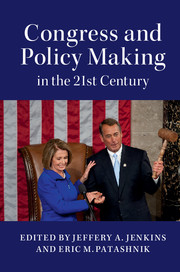Book contents
- Frontmatter
- Contents
- List of Figures
- List of Tables
- List of Contributors
- Acknowledgments
- 1 The Evolving Textbook Congress: Polarization and Policy Making on Capitol Hill in the 21st Century
- PART I CONGRESSIONAL POLICY MAKING IN A POLARIZED AGE
- PART II CONGRESS AND SOCIETY
- PART III CONGRESS AND ECONOMIC POLICY
- PART IV CONGRESS AND DOMESTIC POLICY DILEMMAS
- PART V REFLECTIONS
- Index
- References
1 - The Evolving Textbook Congress: Polarization and Policy Making on Capitol Hill in the 21st Century
Published online by Cambridge University Press: 05 February 2016
- Frontmatter
- Contents
- List of Figures
- List of Tables
- List of Contributors
- Acknowledgments
- 1 The Evolving Textbook Congress: Polarization and Policy Making on Capitol Hill in the 21st Century
- PART I CONGRESSIONAL POLICY MAKING IN A POLARIZED AGE
- PART II CONGRESS AND SOCIETY
- PART III CONGRESS AND ECONOMIC POLICY
- PART IV CONGRESS AND DOMESTIC POLICY DILEMMAS
- PART V REFLECTIONS
- Index
- References
Summary
In 2009, the U.S. Congress, led by House Democrats, sought to tackle the issue of climate change and pass major energy legislation. The American Clean Energy and Security Act (ACES), sponsored by Rep. Henry Waxman (D-CA) and Sen. Edward Markey (D-CA), proposed a “cap and trade” system to limit the amount of greenhouse gases that companies could emit nationally. “Emission permits” would be bought and sold in a marketplace, and the cap would be reduced over time to curb carbon dioxide gases. The ambitious bill generated significant controversy. Environmental groups lobbied for the measure while the petroleum and natural gas industries and conservative advocacy groups sought to block its passage. The bill passed in the House by a slim 219–212 vote, with just 8 Republicans in support. But, the following year, ACES died in the Senate, when Majority Leader Harry Reid (D-NV) acknowledged that he did not have the sixty votes necessary to overcome a Republican-led filibuster.
Since 2010, President Obama has been urging the Congress to pass climate change legislation. But little has been accomplished congressionally, with meaningful policy change made more difficult since the Republicans regained majority control of the House in 2011. In his 2013 State of the Union address, Obama announced that he was prepared to move forward without legislative action. “If Congress won't act soon to protect future generations, I will,” he said (Restuccia and Dixon 2013). Working through the Environmental Protection Agency (EPA), Obama in 2014 established a new regulation that would cut carbon emissions produced by coal-burning power plants by 30 percent from 2005 levels by 2030. Congressional Republicans were immediately up in arms about the executive “overreach” and warned of significant job losses in the coal industry. Obama made no apologies for seizing the initiative, however, and castigated Congress for failing to tackle climate change. And, in June 2014, the Supreme Court largely upheld the EPA's authority to regulate greenhouse gases, though the decision also left open the possibility of future judicial review of rules imposing limits on power plant emissions.
On combating carbon pollution, then, national policy making in the 21st Century is being led primarily by the president with significant input from the judiciary. Individual lawmakers have certainly taken positions and made public statements, but Congress is not a central institutional player in climate-change-mitigation policy making.
- Type
- Chapter
- Information
- Congress and Policy Making in the 21st Century , pp. 1 - 18Publisher: Cambridge University PressPrint publication year: 2016
References
- 1
- Cited by

